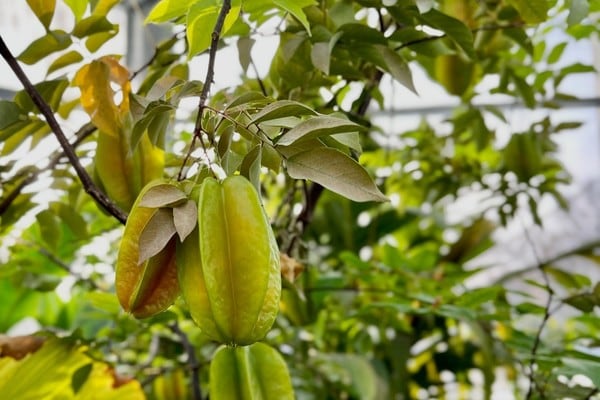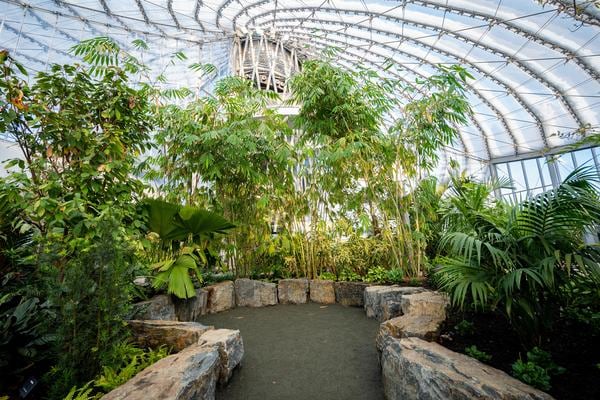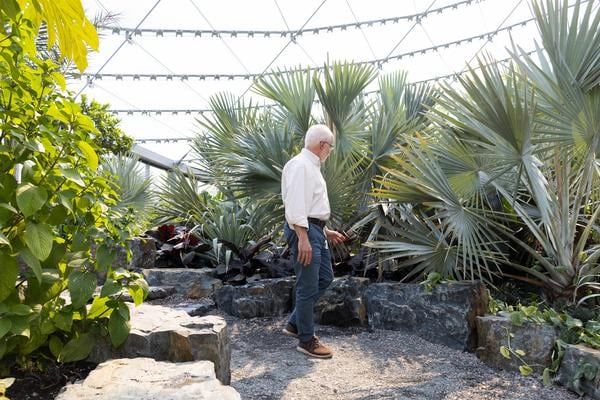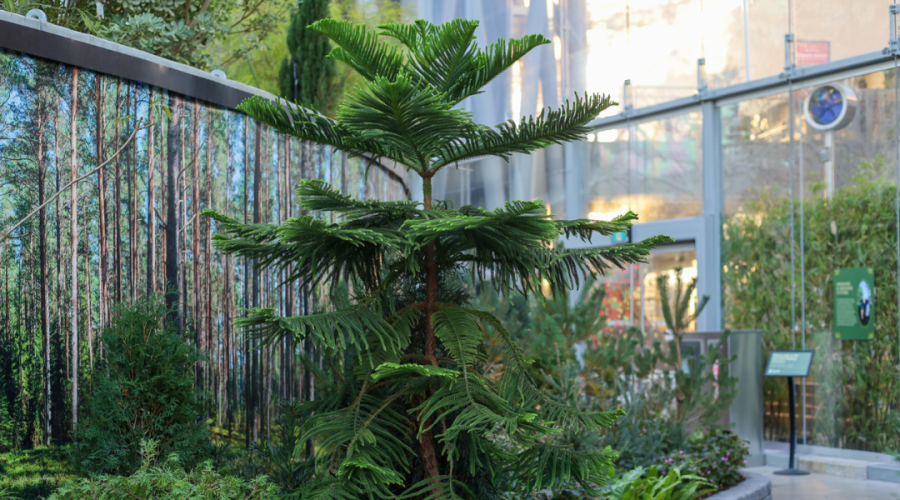Take a tour of the Hartley and Heather Richardson Tropical Biome with Rob Halpern, horticulturist and the plant designer for the Tropical and Butterfly Biomes in The Leaf.
Since founding Zoo Horticulture Consulting & Design in 2001, Rob has created beautifully themed landscapes and immersion experiences outdoors or indoors, focusing on landscape design for zoos, aquariums, indoor living exhibits, botanical gardens, science centers and museums.
Recently Rob visited The Leaf to see how his design has grown and changed since its opening in December 2022.
We asked Rob to take us on a tour of the Hartley and Heather Richardson Tropical Biome. The following is what he said about the design elements, aspects that were considered when planning, and the spaces that will continue to develop over the years. Next time you walk through the biome you will experience it in a whole new way!
The Journey through the Tropical Biome starts with a tropical shade garden. You'll notice plants that don't depend on lots of bright, showy flowers because it's shady. This area features lots of interesting leaves, different colours, textures, and sizes. You will see big leaves next to small ones, and fine textures next to coarse textures.
Walk further on the path and you come to a transition portal. You will walk through a little grove of wonderful palm trees that have huge, round leaves. Now today those trees are maybe a meter and a half tall, but in time they will be four meters or taller, so you can just imagine what it will become.

The tropical shade garden greets you as you enter the biome.

An ariel view shows the diversity of plants featured along the pathways.
Next comes the lowland tropical rainforest, here we have more trees and some flowering plants because we have more light reaching this area. It is very lush and diverse rather than having big groupings of the same plants. Here we tried to accentuate the diversity of plants by featuring many different types, but this is garden design so like in your garden or any garden, even though we're trying to create a tropical rainforest feel, we still need the plants to work with each other. We were working with textures, shades of green, and flowers, we didn’t want it to seem like one foggy mass of greenery, but it has an identity.
If you continue on your journey through the rainforest and it gets sunnier and sunnier because you're moving toward the south side of the building. You round the corner at the big Bodhi tree also known as the banyan tree.
Now we're in the sunny area where we start to see economically important plants. You will find the American oil palms, the coconut palms, and some tropical fruits such as starfruit. Don’t miss the coffee grove!

Star fruit, Averrhoa carambola
.jpg)
Cacao Tree, Theobroma cacao

Bamboo surrounds a seating area.
Next, we make a right turn and as we get into the shady part ahead of us, we step into the cacao grove. Here you see how cacao is grown as an understory plant in tropical rainforests.
Take a moment, sit down, and take a break in the seating area. The bamboo gives you a quiet enclosed moment to relax as you continue around the corner.
Here is your first good view of the big waterfall. You also see the large elephant ear plants and cycads, which look like huge ferns. They are the most ancient plants dating back on the evolutionary scale to prehistoric times. Notice the sealing wax palms, with their bright red trunks and the reddish philodendrons at their base carry colour from the ground up to the trunks.
.jpg)
The first view of the waterfall.

Rob with the sealing wax palms, Cyrtostachys renda.
When you step onto the bridge, all the focus is on the water garden, with plants like papyrus, Thalia, and of course the waterfall.
Next to the waterfall, you see a big fishtail palm. This palm is rather rare. It took a lot of work to find it and someday, the hope
is it will be 10 meters tall, perhaps taller. We chose this tree because we needed something with enough presence to stand up to the waterfall. You can't have little delicate plans to offset it.

Bridge overlooking the water garden.

As you leave the water garden, you come into the sunny tropical garden. You'll see the silver leaf Bismarck palms and underneath them, burgundy leafed and black leafed plants to set off the silver. These design aspects make it clear this is not a subtle shade garden, but rather a modern 21st-century garden.
Now you see the big pandanus, the screw pine, with its candelabra arms. There are two smaller screw pines next to it that add to the sculptural modern feel of this sunny tropical garden. In this area, the plants featured have economic, culinary, and cultural importance.

Bismarck palms, Bismarckia nobilis.
.jpg)
Screw Pine, Pandanus utilis.
As you leave this area, things are toned down. The plant palette gets quieter, greener, and it encloses you more. Everything narrows down a bit. The plants have some growing-in to do, but that's what gardens do. Here, you come to the last view of the pond and the waterfall. This moment sums up where you've been and creates a space to pause before you go into the Mediterranean Biome.
.jpg)





